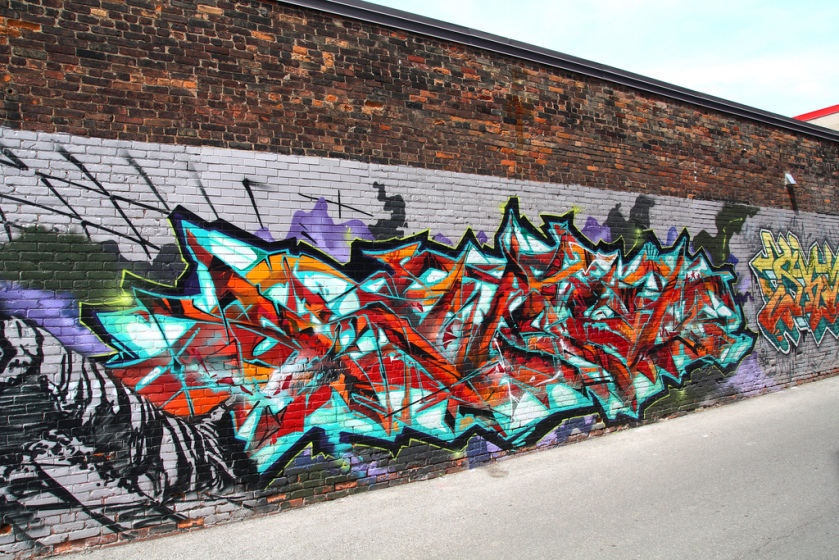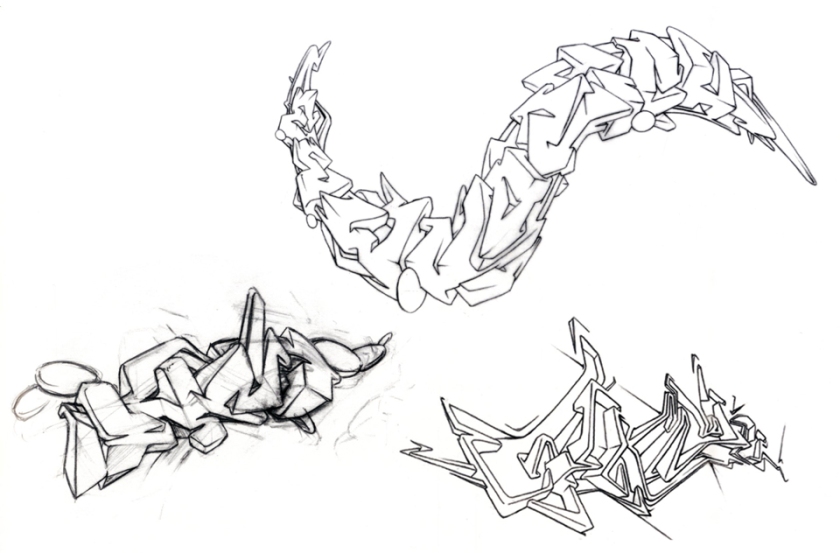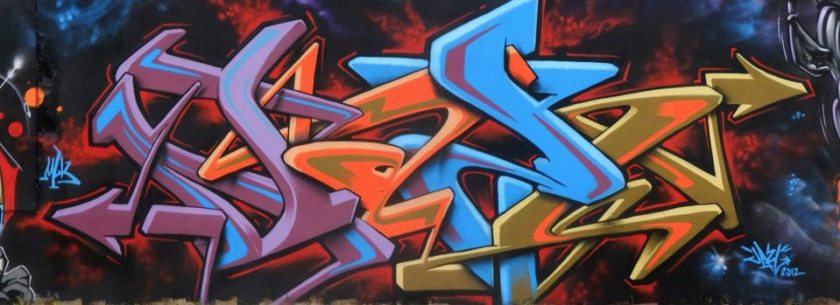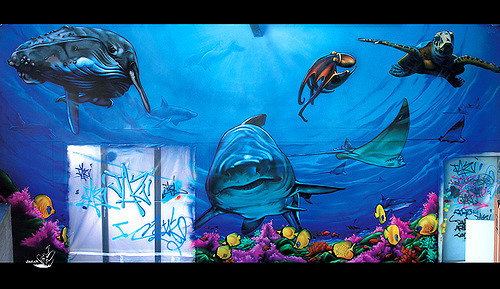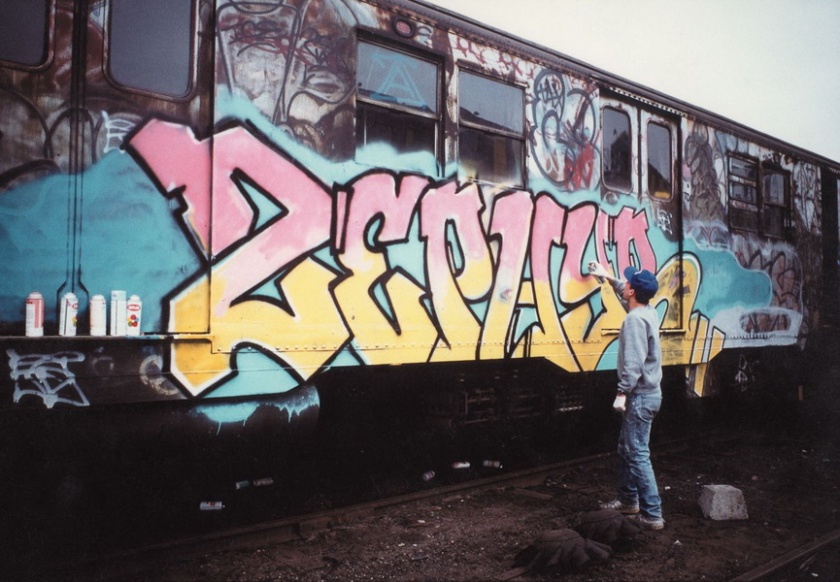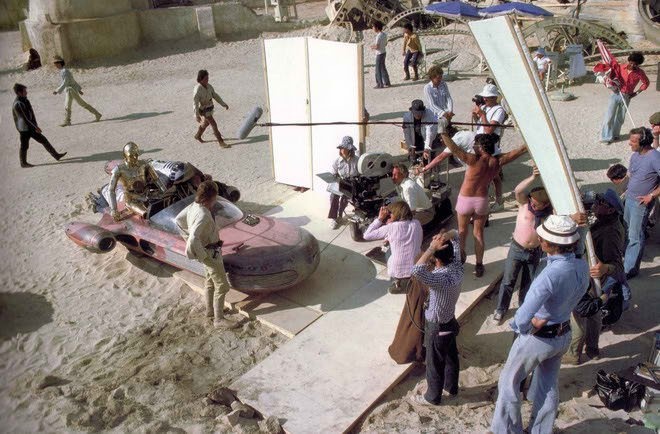
That’s right. The dialogues for one of the most influential films of all time was recorded by a shirtless man in pink shorty shorts.
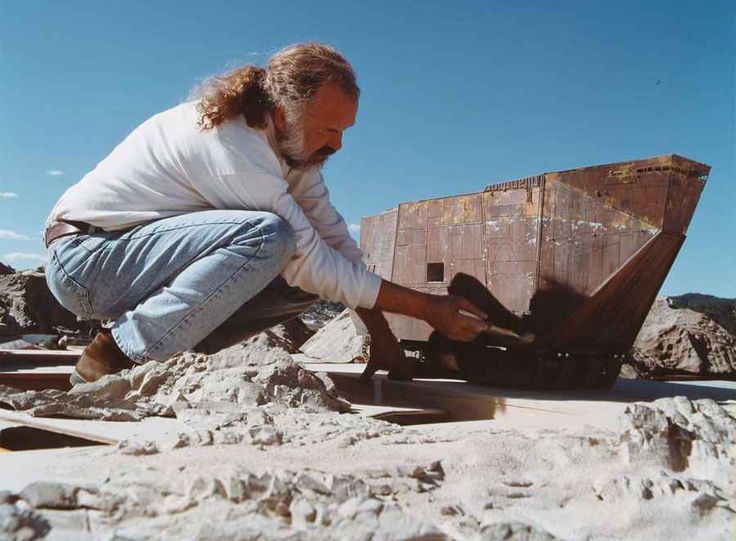
…And directed by a bunch of bearded adults that liked to play with toy cars…er..”Jawa Sandcrawler’s”

…And played by more bearded adults who liked to dress up as space monks and play with sticks.

…Whoop, there we go. Much better.
A Long Time ago in a Galaxy Right Up Our Alley.
Since ancient times, storytelling has been an art form all on its own. People would gather around campfires and tell stories of heroes such as Gilgamesh, Cuchulain, or Samson. Whether fact or fiction, these stories would envelope the minds of the audience, capturing the imaginations of kings and peasants. In a sense, any variation of art is just a variation of storytelling, whether that story is more than a thousand words or briefer than a feeling. Film has been the newest revolution of the storytelling art form. Star Wars: A New Hope, was a revolution all on its own.
The Making of Star Wars: A New Hope, and the Revolution of Modern Film
Directed by George Lucas and released May 25, 1977, Star Wars, collecting close to 800 million dollars, became a huge success and a film sensation. The opening scene alone blew the minds of its spectators, and it is still talked about much today:
On Camera Angles:
Nothing of this scope or magnitude was attempted before then. The noise of the Star Destroyer passed over the heads of the captivated audience. The enormity and power of the Imperial conflict came into scope. The setting was no longer a western house on a prairie, or a boat on the shark infested ocean, but rather an entire galaxy. All this information swelled the minds of those who watched, and that was only the first five seconds. That’s the power of a good camera angle, and a team of highly ambitious people.
The Screenplay…
…was also written by George Lucas. In itself, it is also revolutionary. It brought in so many new concepts, species, languages, characters, and worlds. One interesting aspect is the time of the setting itself. The scene opens right in the middle of the conflict, which has gone on for generations by now: Episode IV… what was that all about? Did we miss something? We are brought in and captured by an Imperial Star Destroyer right out of nowhere. From the get-go, the story was set up to capture both our amazement and curiosity, and in more dimensions than one. The scene transitions to a desert planet, and a stargazing farm-boy. It all of a sudden becomes relatable. The film takes on a pseudo-wild western aspect: dark side, light side, complete with gunslinger Han Solo. Metaphorically religious aspects are also included, complete with prejudices from our smuggling Byronic nerf-herding hero, “Hokey religions and ancient weapons are no match for a good blaster at your side, kid.” In short, there’s something for everyone, and the screenplay takes on a holistic detail-oriented portrayal of a universe we have no choice but to be drawn into.

A word more on Han Solo:
He made the Kessel Run in 12 parsecs. How? The same way he did one of the most dramatic scene transitions of all time:

Docking Bay 94 on Tatooine to the Alderaan System in a few minutes. Well, not quite, but once the hyperdrive is up and working, there is no more dynamic scene transition in all of film. They make it to an Aleraan that no longer exists. Plot twist. But let’s at least give props to Han and his furry copilot for putting on a show.
Speaking of furry copilots…
…and furry…
…and well…
…these guys:



Costumes, makeup, puppets, everything comes into play here. Some are outrageous, and others more believable. I’m showing pictures simply because descriptions wouldn’t do them justice. The scope of the movie would not be complete without a few extras and lesser known characters. We get a feel for the expanse of the setting, with what seems like a wild west undertone at the Mos Eisley Cantina. It is here that Greedo (#4) threatens Han Solo: a scene necessary to show the space pirates true nature. Greedo’s small performance lives on. Have you heard the saying, “Han shot first?”

The Conflict, and the Symbolism that made it stick:
Shakespear’s Hamlet had a line that said, “The play’s the thing wherein I’ll catch the conscience of the king.” The story had to be something the audience could connect to, and George Lucas knew what it had to have to make it stick to “the conscience of the king” so to speak. Star Wars has some very real, almost harsh, symbolism. The Force is described briefly by Ben Kenobi, but throughout the series it does not truly explain what the Jedi believe. It introduces an almost spiritual aspect, a religion of sorts, but it is kept vague enough that there are few or little arguments. Darth Vader’s costume is another motif, black, robotic, cybernetic, not totally himself. It symbolizes the dark side in a sense. The empire symbolized Nazi Germany. Lucas had to tiptoe around a lot of these themes, but this one was obvious enough that he actually named the Storm Troopers after the Storm Troopers which were part of the Nazi assault division which helped Hitler rise to power. Han Solo couldn’t have a more American style to him, possibly one of the reasons he was chosen as a main hero. America defeated Nazi Germany. The symbols keep rolling throughout the franchise, and they are one of the reasons the story remains so rich.
The Music and Sounds:
It makes a difference….
If you click nothing else on this blog, click and compare these two scenes:
Exhibit A: Star Wars ending scene with music and sound effects
Exhibit B: Star Wars ending scene without music and sound effects (don’t pee your pants laughing after 0:36)
I don’t know what way to illustrate how much good music and sound effects make, other than showing what it is like without it.
The music was orchestrated and directed by John Williams. Williams conducted the London Symphony Orchestra at Anvil Studios in Delham, England. All of the music was new and original. The Star Wars soundtrack became as iconic as the film itself.
Foley artists were employed to create the sounds of R2D2, Chewbaca, the X-wings, and any other spaceships. Even Darth Vader’s voice was changed over from another actor, because they didn’t want him sounding like a high pitch Scottish guy:
In short, sound effects were the saving grace for this film. So were visual special effects. As seen in the beginning, they make a difference. Hyper-drive just wouldn’t be the same without visual effects. Old men with plastic sticks become Jedi knights, toy airplanes become X-wings and Star Destroyers, toy cars become enormous Jawa Sandcrawlers, green-screens become worlds, and the Tatooine sunset now has two suns:
The Tatooine sunset:


I think one of the most subtle effects used was the additional sun placed in Tatooine’s sky. The effect is mostly done with just lighting, but the scene becomes so unique and iconic that Yoda has to mention it in the next film; “All his life has he looked away… to the future, to the horizon. Never his mind on where he was. Hmm? What he was doing.” The scene shows just that. It becomes his last look, symbolic in a sense, of his old life. His new life awaits somewhere beyond those two stars. The familiar warmth of the light is also something he will miss, as his future steps further into cold conflict and the unknown.
My Tatooine Horizon:
In a sense I’ve always been a horizon viewer, the same as Luke. I’ve always been a dreamer, and artist, a traveler. Star wars in a small way had a huge impact on me as a kid. It taught me that nothing was impossible. Even as a kid I was fascinated with how they made the film. I was the kind of kid that took apart the telephone to see how it worked, or climbed on top of the house to see how much farther I could hit the golf ball. So a film like this got me excited in a lot of ways. Early on I was exposed to the concept art, the special effects, the acting. Looking at it now is still amazing. Film-making and animation are some of the venues I’m exploring, and I’m amazed at the collective work that the Star Wars team has put together. So the film evoked emotional responses on me for more than just the story. As a kid, it was exciting, adventurous, and it allowed for a little rebellion (as a kid that’s a huge plus). And let’s face it, great Lego sets came out of that franchise. Looking at it now kind of brings back those memories. We never really know what Luke is thinking about, looking into that sunset, but when I see it now, it is looking back, and not to the future.
Sources:
1.) I’m a well-versed nerd; it counts 🙂
2.) Wikipedia, Star Wars Soundtrack,
https://en.wikipedia.org/wiki/Star_Wars_(soundtrack)
